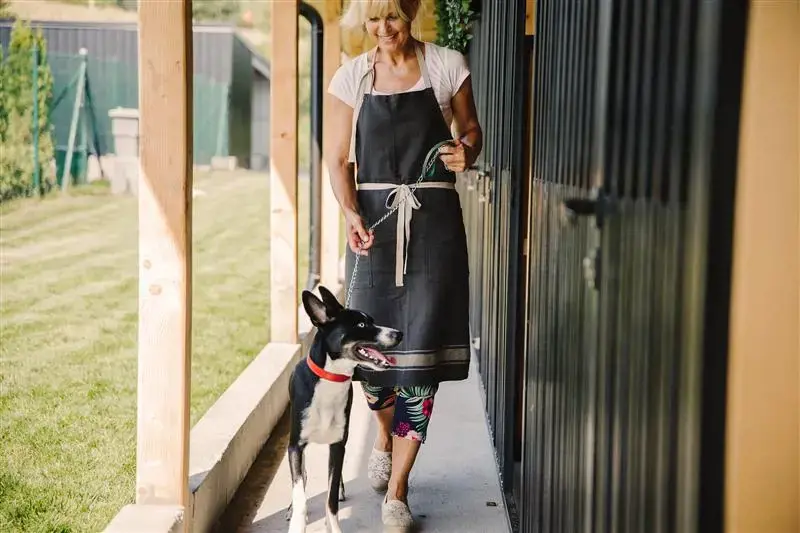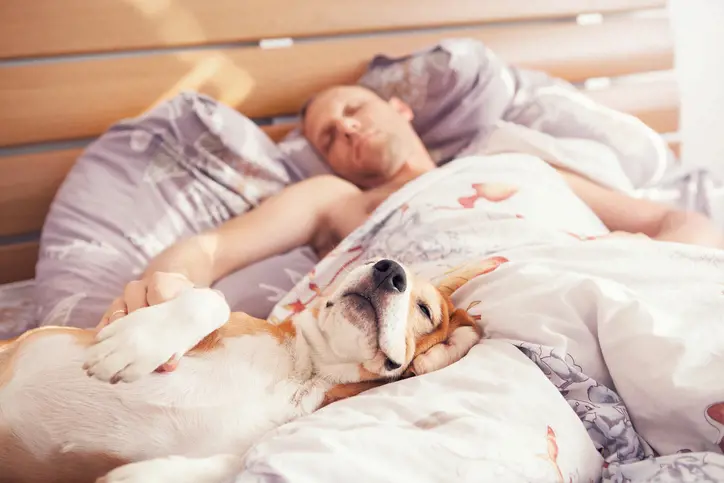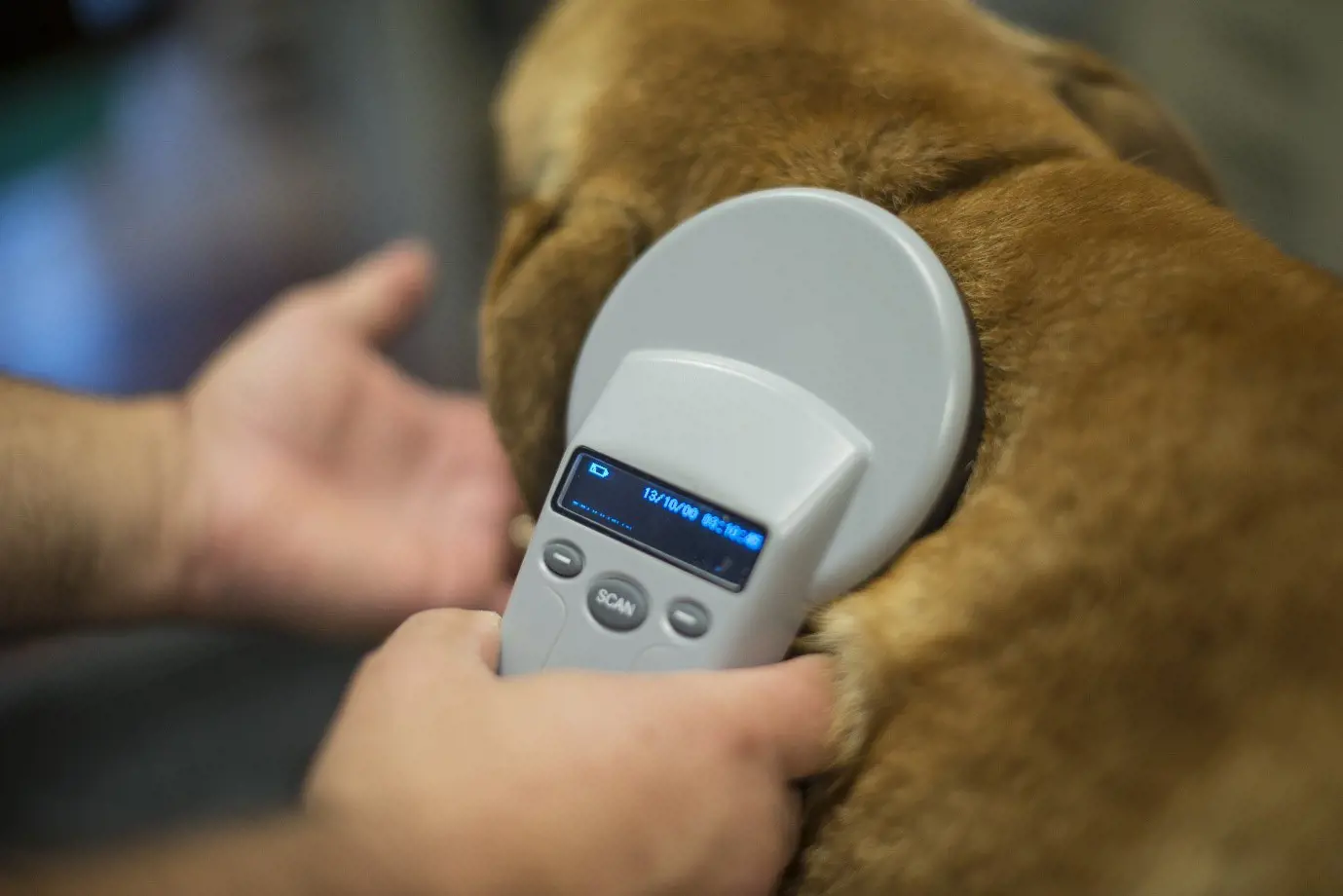60 tips for travelling with pets
5th May, 2022
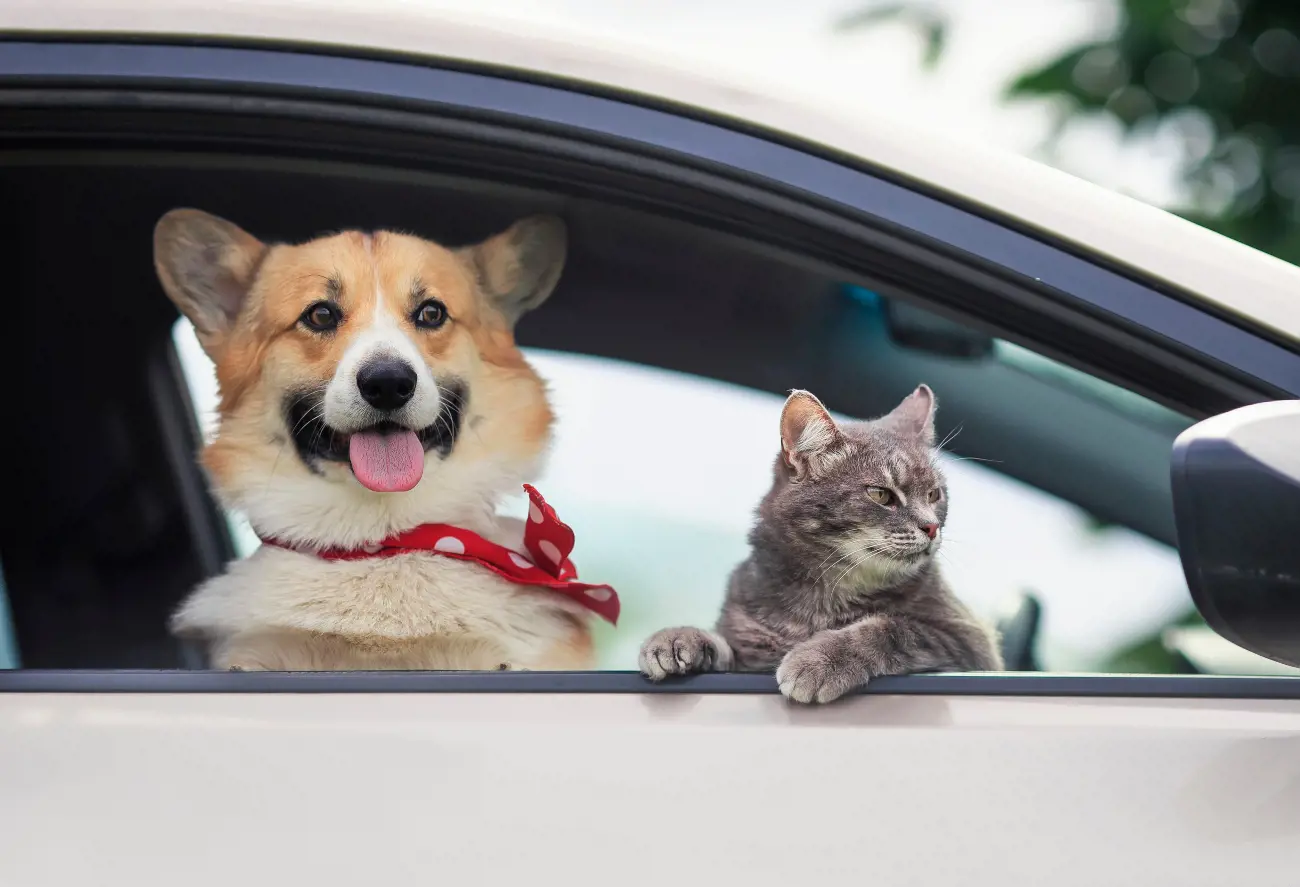
Taking your dog or cat on a little trip this summer? As long as you’ve got pet insurance in place and you’ve read these essential tips, you’re guaranteed a bon voyage! Here we give you some quick advice on transporting your pet by car, train, and air. We also look at the rules and regulations of taking your pet to the EU and beyond.
Car travel
1. Ask yourself: Do they really need to travel?
Let’s take dogs first. If you can still spend a decent amount of your time with them while you’re away, then they may benefit from coming along. On the other hand, if you’re likely to be busy most of the time or leaving them in your holiday home while you go off on adventures, they’re probably better off staying with a friend or at the kennels. Cats, meanwhile, are self-sufficient creatures who are almost always better off left at home than being dragged off on an unfamiliar journey. If your feline is staying at home rather than at a cattery, ask a nearby friend of neighbour to feed them and let them in or out while you're gone.
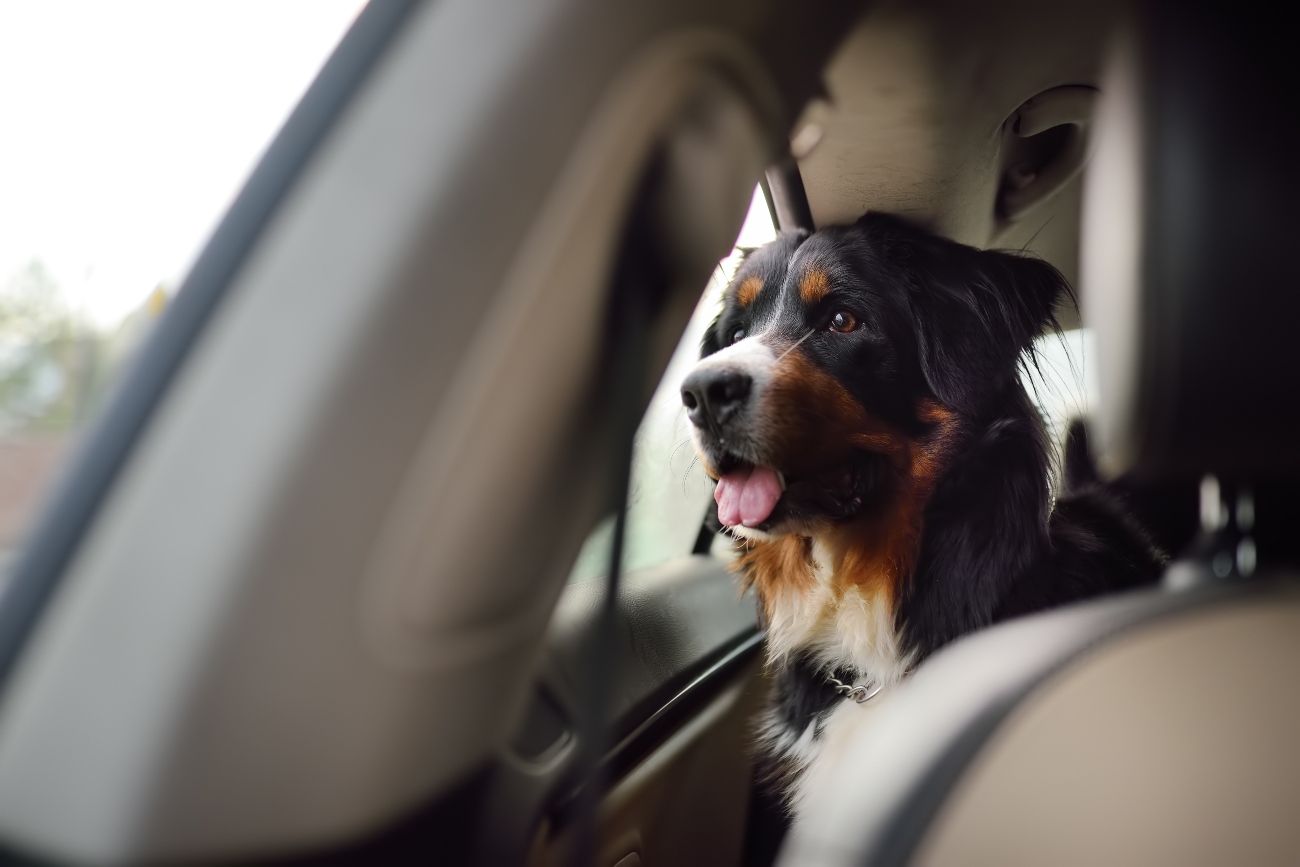
2. Make sure pets are secured
If you're travelling by car, your dog should be restrained in a suitable crate or behind a dog guard. You could be charged with driving without due care and attention if your canine is left to wander around inside the car and cause a distraction. In the event of an accident, they could injure themselves or other passengers if they’re not held safely in place.
3. Cats and carriers
Cats in cars should be kept in a carrier. Riding in a car tends to be an unpleasant experience for a cat, so we wouldn’t advise travelling with your feline friend unless you have to. If the carrier has been crash tested, it can be restrained with a seat belt and placed on a back seat. If it hasn't been crash tested, place it in the footwell of your vehicle behind the driver or passenger seat.
It should also be big enough for your pet to turn around.
4. Don’t sit pets in the passenger seat
They are far better off in the back seat. The reason for this is that, if your vehicle is involved in a crash, airbags will deploy towards the two front seats to protect occupants from hitting the windscreen. This will be a key protection for you in the event of a crash but, for a much smaller animal like a dog or cat, the airbag could actually cause an injury – even if the animal is inside a carrier. Besides being upsetting for both you and your pet, that could lead to some expensive vet bills, even if your pet insurance policy is able to bear some of the cost.
5. Don’t let dogs lean out of the window
A blissfully happy dog leaning out of the car window, sniffing the breeze while its ears are pinned back by the wind may be an iconic image of freedom and fun. But this practice is definitely not recommended in real life. Dogs who are allowed to poke their heads out of the window could easily be hurt by flying debris, other traffic, flies, insects and more which could all result in a claim on your pet insurance.
6. Plan plenty of rest stops
Dogs will need to stop frequently (every hour or two) to stretch their legs and do whatever toileting they need to. Just make sure your dog is wearing its collar and lead whenever they leave the vehicle so they can be traced if they do run off. Some pet insurance policies will help you cover the cost of advertising if your pet does run away.
7. Take another human passenger along
If you’re travelling with a cat or dog, the trip will be a whole lot easier – and safer – if you have a companion along for the ride, too. This is for a couple of reasons.
Firstly, you really don’t want to have to concentrate on both the driving, and keeping your furry friend amused. It’s better if someone else can be in the car with you, making regular checks on your pet. Secondly, whenever you do need to make a pit stop of your own – to get food or a coffee, use the toilet – you can do so secure in the knowledge that someone else is keeping an eye on your beloved cat or dog.
Certain breeds are targeted by thieves, so it’s best not to leave them alone where they could become easy pickings for criminals.
8. Never leave your pet alone in the car
If pets are left alone in an enclosed space like a car, heat can become a serious hazard. If the temperature outside is 29 degrees centigrade, the interior of the car can rise to a lethal 39 degrees within 10 minutes. These temperatures can be extremely dangerous for animals, possibly resulting in organ damage or even death. Learn more about the signs of heatstroke now.
9. Ditch the loud music
There are some things you can do to keep the in-car atmosphere as calm as possible for your pet during your summer road trip. Loud music should be avoided, as both cats and dogs have sensitive hearing and anything too noisy could heighten their anxiety. However, some calming classical or ambient music, played at a low volume, could cover the noise of the surrounding traffic and create a calming space.
10. Drive sensibly and predictably
Try to keep your driving as calm and predictable as possible, avoiding any sudden braking or noisy gear changes. Keep to the speed limit, too, and don’t get distracted by your phone.
Air travel
11. Think seriously before taking your pet on board
When it comes to travelling by air, this is once again – perhaps even more so – a situation where you should ask yourself, ‘is this really the best option for my pet?’ Air travel – and in particular, confinement in an enclosed space for a prolonged period of time – can be dangerous for pets. This is especially true in the case of brachycephalic animals – those pets such as bulldogs, pugs or Persian cats that have somewhat compressed faces. Their facial structure means they’re more vulnerable than most to oxygen deprivation and heatstroke. So, once again, consider the alternatives. Your pet might well be better off with a pet sitter, being visited by a friend or neighbour, or even at a boarding kennel or cattery, than travelling in the hold of an aeroplane for even a short time. If you’re considering the kennel option, by the way, we’ve written this helpful article on how to help your dog settle in at kennels.
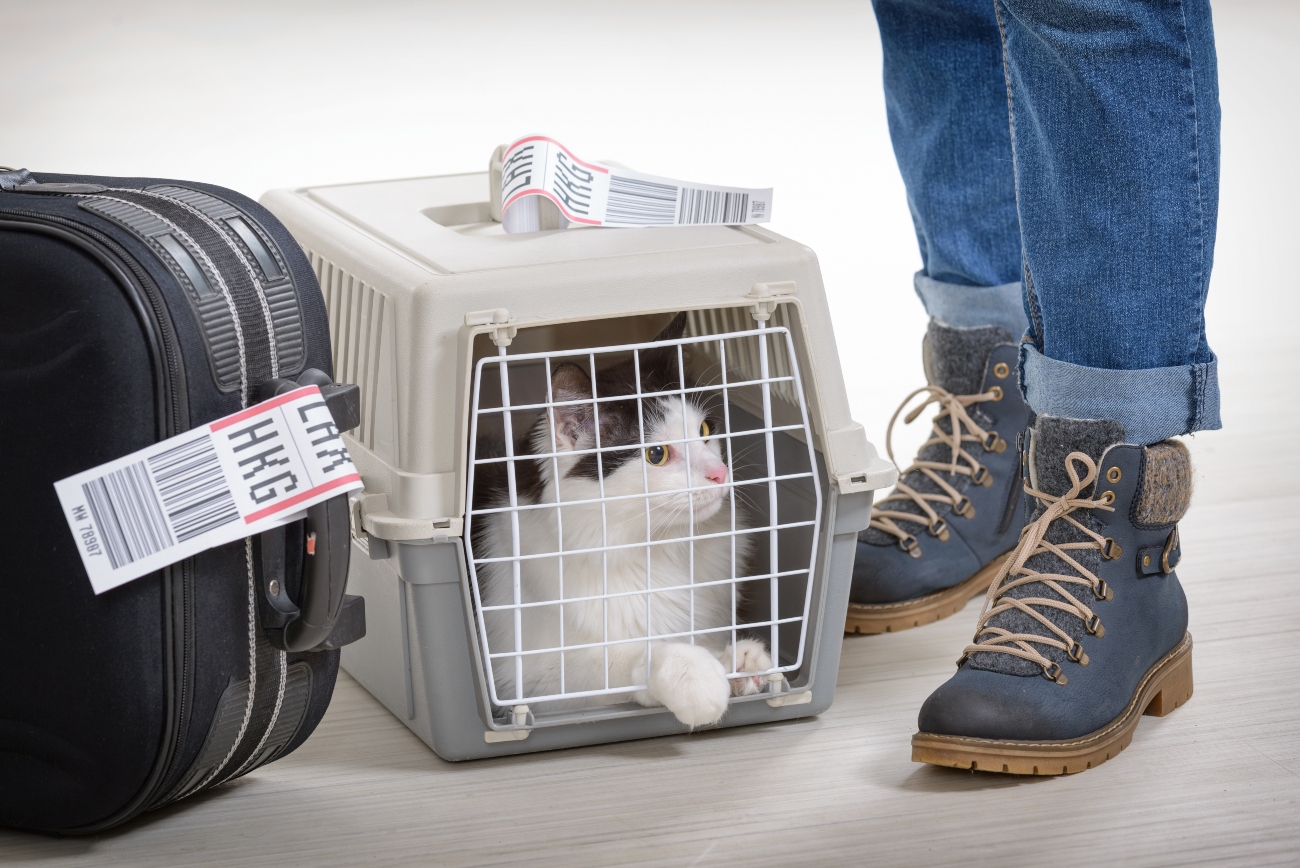
12. Can your pet travel in the cabin with you?
If you have no choice but to bring your pet on a plane with you, it’s worth checking whether they can travel in the cabin, rather than suffering the confinement and confusion of being stowed away from you in the hold. Many airlines will allow cats or small dogs into the cabin, for a small fee. Call the airline as far ahead of time as possible, as they will have a limit on the number of animals they can take in the cabin and these places can get snapped up. If you’re travelling with a dog, the airline will want to know the size and breed. They will have their own specific guidelines on what size of pet is permitted in the cabin.
13. Further questions to remember
There are some other questions you should ask yourself before deciding to take your pet on a plane.
- Does the airline have certain rules around pet health and immunisation? They may need to see recent vet reports or vaccination certificates.
- Do they only accept certain types of carriers? If your pet can’t be in the cabin but must go in the hold, what will that mean, in terms of both the regulations and the conditions for your pet during the flight?
14. Keeping a pet comfortable in an aeroplane hold
If your pet has to travel in the hold, try to make the experience as stress-free as possible. Make sure you travel on the same flight, so that you can watch them being loaded and unloaded. Being placed in the hold, away from you and among other unfamiliar animals, may be stressful enough for them: don’t add an unfamiliar carrier to their anxieties.
At least a month before your flight, start getting them used to being in the carrier (if they are not already). Start with small periods of time and give them a treat or some affection when time is up. This will give the carrier some positive associations for them. If you’re travelling during the summer, the hold could get very hot.
You can minimise this risk by travelling at certain times of the day when the temperature is less extreme. In the unfortunate event that your pet does suffer some ill effects from confinement in the hold, make sure that you have some pet insurance in place to help with the costs of treatment.
15. Bring your pet’s ID on flights
Make sure that you have your pet’s ID with you in case you are separated. We would suggest fixing two pieces of ID to their collar. One should have your permanent address and phone number, the other your contact details while you are away. Also make sure that you have your pet insurance details on you and that your pet is covered for travel to the country you’re visiting.
Train travel
16. Pets and train travel: the essentials
Now let’s look at travelling with your pet on a train within the UK. The good news here is that, as long as they are kept on a lead or in a carrier and don’t annoy or endanger other travellers, you are allowed to carry a maximum of two pets on most British train services.
If you need to bring more than two animals on the train, you’ll just need to check with the relevant train company. There may be a fee involved. Here is the policy of one of the major operators, Great Western, as an example.
17. Preparing your pet for train travel
Just as with transporting a pet in the hold of an aeroplane, it’s a good idea to get your pet used to the sights, sounds and smells of rail travel before the journey actually takes place – especially if you have a dog. We’d definitely recommend arriving at the station a little early, and giving your pet a bit of time to get used to the station ticket hall, followed by the ticket barriers and, finally, the platform. And, as with any new situation for your dog, reward good behaviour – such as obeying your command to ‘sit’ – with a treat or a cuddle or both!
18. Recognising signs of travel anxiety in your pet
Whatever mode of transport you’re using, be ready to recognise any signs that your pet is uncomfortable or unhappy. Dogs will show their discomfort or anxiety by panting or pacing around, lip licking, chewing their lead, whining, or tucking their tail between their legs. If you’re on a train with your dog and they start to display these behaviours, it’s best to get off at the next station. That may cause you some inconvenience, but this will be better than having an angry, anxious, or frightened dog in a confined place. An anxious or angry cat will hiss, have their ears pinned back, and have a puffed-up tail. Angry pets are unpredictable pets, and they could injure themselves or other people. Make sure you’ve got pet insurance in place to cover the costs of any emergency treatment that might be needed.
Please note that we do not cover aggressive dogs under our pet insurance policies. Always check your policy details to ensure you have the appropriate coverage.
19. Choosing the cat carrier
The right carrier could make the difference between a calm trip and a stressful one! When it comes to a cat carrier, you should choose a model that is made of a durable material – usually plastic. This will be tougher than fabric, and more comfortable than wire mesh. It’ll also be easier to clean. Make sure that the carrier is a suitable size for your cat – tall enough to allow them to sit or stand up inside, and long enough for them to move around and lie down. Larger cats, such as Maine Coons, will need bigger carriers.
Travelling abroad
Purely Pets will not provide coverage for third party liability in non-EU countries. Additionally, non-urgent treatment that could wait until your return to the UK is not covered. Furthermore, vet fees are not covered if the journey abroad was specifically made to obtain treatment.
Please ensure you check the terms and conditions of your pet insurance policy for detailed information on coverage and exclusions.
20. Travelling abroad: EU countries
It’s important to know the regulations for travelling abroad with your dog or cat. Essentially, the rules vary according to whether you’re travelling to a country within the European Union (EU), or a non-EU member country.
If you are travelling to an EU country, or to Northern Ireland, you will need a microchip for your pet. You may have this in place, as here in the UK it’s already a legal requirement to microchip your dog and cat. For cats, meanwhile, microchipping is not yet a legal requirement – but it is recommended by bodies including the British Veterinary Association, as we discussed elsewhere on our blog.
Other requirements for travel to the EU or Northern Ireland include a valid rabies vaccination. This applies to cats as well as dogs, as cats are also susceptible to the disease. You can get a rabies vaccination from your vet: this will typically cost around £50-£90, but your pet insurance policy may be able to help with the cost. Two key timings to mention here: your vet will require proof that your pet is at least 12 weeks old before administering the vaccine; and you will then have to wait until 21 days after the vaccination before you can travel to the EU or Northern Ireland.
Staying with the EU and Northern Ireland, you’ll also need an animal health certificate or a valid pet passport for your destination country. Like the rabies vaccination above, you’ll need to ask your vet for an animal health certificate – and you’ll need to get this sorted in the 10 days before you travel.
In order to issue the certificate, the vet will need proof of your pet’s microchipping date and vaccination history. The certificate will then be valid, from the date of issue, for 10 days for entry into the EU or Northern Ireland, as well as four months for onward travel within the EU and/or re-entry into Britain.
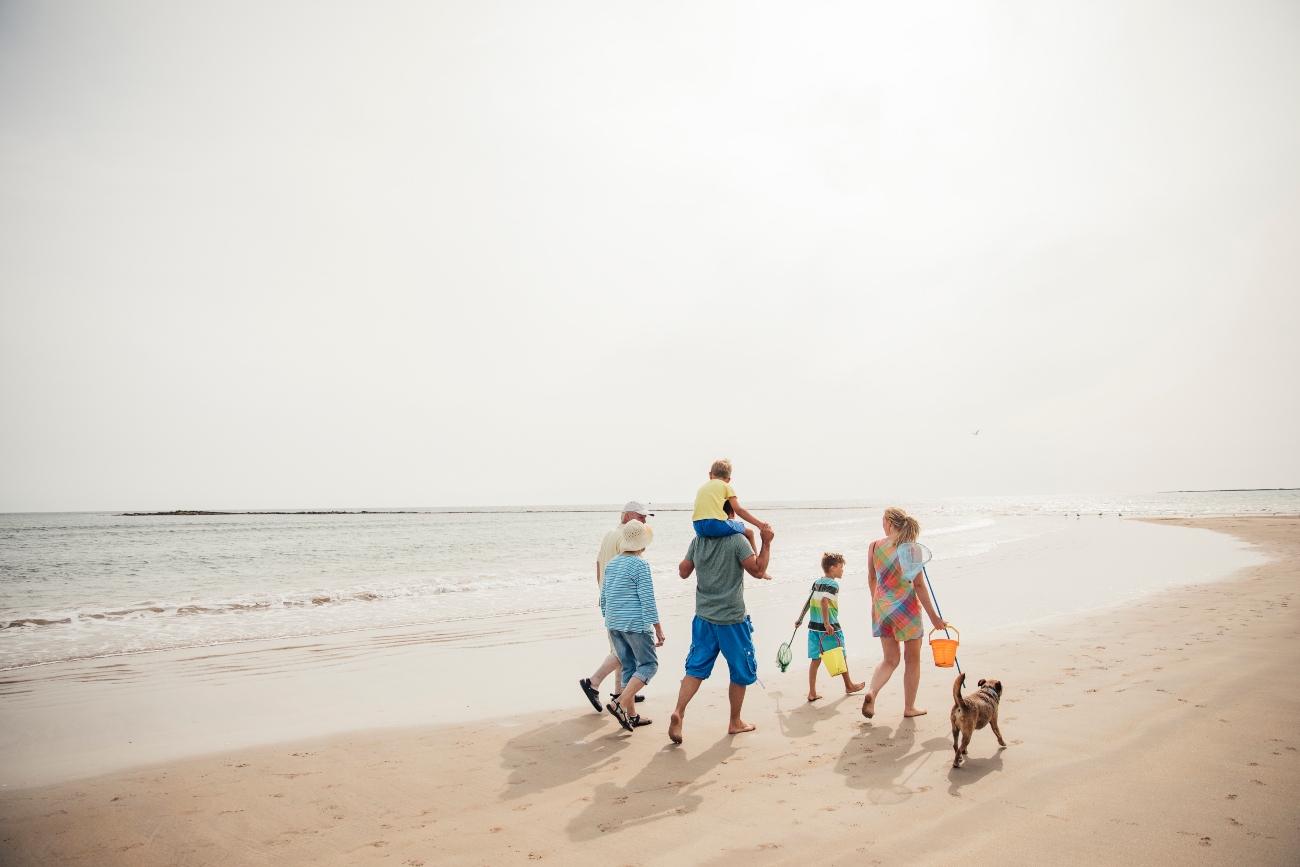
21. Travelling abroad: Non-EU countries
If you’re visiting a non-EU country (apart from Northern Ireland), the rules will be slightly different. In this case, you’ll need to get hold of an export health certificate, or EHC. This is an official document that confirms that whatever you are exporting (in this case a pet) meets the health requirements of wherever you’re going.
How do you go about getting an EHC? Well, you must nominate a vet – the vet that you regularly see, and who knows your pet, will be the best choice here. The vet will be sent the EHC and will then verify that your cat or dog meets the relevant country’s health and identification requirements.
Remember the essentials!
It goes without saying that you also need to have your pet’s essentials with you when you travel, to make sure they’re happy and comfortable:
Things like:
- Enough food and water for the entire journey
- Poo bags for toilet stops
- Favourite toy to play with during breaks
- Treats to reward good behaviour
- Lead or harness for controlled walks in unfamiliar places
- Dog coat or jacket if you’re going to a cold climate
- Any medications they need
- Evidence of your pet insurance
Basic dog training
22. Start early
Your relationship with a dog starts as soon as you bring them home. This is why it’s important to begin training as soon as you can. Training helps to build trust and establish those all-important boundaries, making the process easier overall. Start with basic commands like ‘sit’ and ‘stay.’
23. Positive reinforcement
Positive reinforcement is an effective dog training method which rewards your dog for displaying good behaviours whilst avoiding punishment for annoying ones.
If you give your dog a command and they react as expected, be ready to reward them. Praise and healthy rewards build an association between good behaviour and nice things, whilst also strengthening the connection between the both of you.
It’s just as important to make sure you’re not inadvertently rewarding unwanted behaviour. Don’t want your dog to demand attention by barking? Don’t acknowledge them when they try it. Simply wait until they’ve calmed down and then respond.
24. Consistency is key
Being consistent in how you act and use commands is the key to simple and effective training. Set a training goal, choose a simple word or phrase to use as a command, and decide how the goal will be met.
When you give a command, make sure it is followed through from start to finish and expect the same outcome from your dog every time. Only give praise or a treat if the task is completed as expected. By repeating the pattern and keeping communication consistent, your expectations should eventually be met.
Consistent training techniques will help to form your dog’s temperament and continue to build trust.
Check out our Good Behaviour series for more training hints and tips!
Hiking safety
25. Check your dog’s fitness
Before taking a hike, it’s important to make sure that your dog is fit enough to come along. You should consider their physical condition and take their age, breed, and overall health into account. If you’re not sure whether your dog will be up to the challenge, it’s better that they don’t join you. Make sure there’s someone at home to look after them whilst you’re on your hike.
26. Use an appropriate leash
Even if dogs are allowed on your planned route, don’t let them off lead. Keeping them on their leash gives you more control over your dog and could help to stop them chasing any wildlife you may come across. Not only that, but it helps you to manage interactions with fellow hikers and their dogs. Overall, keeping your dog on the lead keeps them safe.
27. Prepare for the hike
Hiking is a fun yet strenuous activity that needs preparation on your part, and your dog’s. More than a walk in the park, a hike is something to build up to. So, start your dog on local nature trails to help them get used to the environment and work your way up to longer routes to build their endurance. As your dog gets stronger, you can look at increasing the length and building up the difficulty of your hikes.
28. Pack all the essentials
You wouldn’t set out on a hike with nothing to hand, and neither should your dog. With that in mind, make sure to bring essentials for them such as water, food, and treats. It’s also wise to pack a dog first aid kit, poo bags, a towel, and any other necessities. You never know when you might need them!
29. Research the route
Trails can be flat, well-maintained, and have rest stops along the route. They can also have steep inclines, mud patches, and water to cross. Check any potential route thoroughly before settling on it to make sure that it’s suitable for your furry companion. On the day of your hike, check that conditions are good before you leave, just in case you have to change your plans.
30. Keep hydrated
Make sure there’s always plenty of water available for you and your pup during a trek. Start by filling up a water bottle at home and bringing a collapsible bowl along to help keep your dog happy and hydrated. When you’re getting low, take opportunities to fill up your bottle with fresh drinking water. Some walking routes have refill stations along the way, whilst others may have cafes, pubs, hotels, and restaurants that’ll be willing to provide fresh water.
31. Manage heat
Avoid walking your dog during the hottest part of the day. Hot surfaces, such as pavements, can burn their paws and over-exposure to heat may lead to heatstroke. Stick to the shade wherever possible and keep your dog hydrated throughout your hike. If it’s too hot for your dog to hike, leave them at home and make alternative arrangements for their care.
32. Leave no trace
Always clean up after your dog and dispose of all rubbish appropriately – including dog waste.
33. Use courtesy
Watch out for other hikers and keep your dog well under your command, this will help to make sure they don’t end up harassing other people or their dogs.
34. Keep an eye on your dog
If your dog’s behaviour changes during a hike, be ready to take a break or adjust the route to suit their needs.
Water safety
35. Never leave dogs unattended
It doesn’t matter how good a swimmer you think they are, never leave your dog alone in or near to water.
36. Introduce water gradually
If your dog has never been swimming before, make sure to introduce them to water gradually. Start in shallow waters and encourage them using positive reinforcement techniques.
37. Doggy life jackets
If your dog isn’t a confident swimmer, or the water is deep, consider investing in a life jacket to help keep them safe.
38. Rinse thoroughly
After a swimming session, rinse your dog with fresh water. This will help to remove any salt, algae or chemicals which may irritate their skin.
39. Dry their ears
Dry your dog’s ears very carefully after swimming as it helps to stop ear infections developing.
40. Give them fresh water
Fresh, clean water should always be available to your dog. Bring a water bottle and collapsible bowl to make it easier for them to drink. Without fresh water, they may be tempted to drink contaminated water from a lake or river.
41. Avoid swallowing lots of water
Keep swimming sessions brief to stop your dog from swallowing too much water. This will help to avoid water intoxication.
42. Watch out for hazards
Be mindful of potential hazards both in and around the water. Things like fishing hooks, currents, or other creatures could create issues for your dog.
43. Understand your dog’s limits
Respect your dog’s boundaries and don’t force them into water if they’re scared.
44. Canine CPR
Learning canine CPR by taking a veterinary first aid course could save a life in an emergency situation.
Car safety
45. Restraining your dog
From seatbelt harnesses and pet carriers to dog cages, there are many ways to keep your dog safe in the car. Restraints also make sure your four-legged friend can’t distract or injure you or themselves during the drive. As we already know, fines and penalties are a very real possibility when driving without the appropriate safety aids in place.
46. Car training
It’s easier to teach new behaviours to dogs whilst they’re still puppies. So, make sure to introduce your puppy to car travel as early as possible.
Make a habit of taking your dog out in the car, even more than you might otherwise. This will help them get used to the movement of a vehicle. By exposing your dog to the car over time, you’ll soon teach them that it’s a fun place to be.
Remember to bring your pup’s favourite toy and some treats which your passenger can give to them during the drive. This may help to take away some of the stress of travelling.
47. Avoid the front seat
We’ve said it before but it’s worth repeating that dogs are banned from travelling in the passenger seat. They are a potential distraction and could easily injure themselves if airbags were to be activated.
48. Dog-proof your car
It’s rare that a driver and their passengers are the only occupants of a car. Many of us keep all sorts of bits and pieces in our vehicles, some of which may be able to harm our pets. Do a thorough sweep of your car and remove anything dangerous before securing your dog for a journey.
49. Never leave your dog in a hot car
Leaving your dog unattended in the car may lead to heatstroke, which can be fatal.
Giving them water or leaving a gap in the window might not be enough to avoid terrible consequences, so don’t take that risk!
Must-haves for adventurous pets
50. Harness and leash set
If you’re heading off on a hike with your furry friend, a harness and leash are safety essentials. The set you choose must be both sturdy and comfortable to keep your pet happy and prevent any would-be escape artists from getting loose.
51. Pet carrier backpack
Smaller pets, or those not accustomed to walking on a lead, may prefer a pet backpack. It’s a great alternative that’ll help to keep your companion safe on holiday. The ideal backpack should have breathable mesh, as well as plenty of space to allow movement. Choosing the right backpack will mean your pet gets to enjoy the scenery whilst you get your steps in. It’s a win-win situation.
52. Portable water bottle and bowl
Just like us, our pets should never be expected to hike without access to water. Keeping them hydrated is a priority, which is why a leak-proof bottle and bowl are a must-have on every trek.
53. Collapsible pet crate
If you’re planning to combine a camping trip with a hike, a collapsible pet crate is a lifesaver. You can use it as storage in your tent or create somewhere cosy for your dog to relax.
54. Extendable leash
A sense of freedom is part and parcel of both hiking and camping. The luxury of an extendable leash gives your pet the ability to roam safely in open spaces without compromising on their security. You also have the power to reel them back in if needed.
55. Pet first aid kit
Planning for every eventually means accepting that accidents can happen, which is why it’s always better to be prepared. First aid kits for pets need to have all the essentials for minor scrapes whilst on the road. Your kit should include things like bandages, antiseptic wipes, and tweezers.
Pet-specific kits will be designed with your furry friend in mind and give you the confidence that you’ll be able to handle any unexpected hurdles until you can get your pet seen by a vet.
56. Protective booties
Summer adventures can offer up everything from wet and muddy conditions to rough trails and rocky terrain. Booties will help to keep sensitive paw pads protected against things like sharp objects, hot surfaces, and slippery paths, allowing your pet to walk both comfortably and confidently.
57. Pet-friendly sunscreen
Remember, pets can get sunburn too. Keep your pet’s health and well-being at the forefront of any plans and pack pet-safe sunscreen for every trip out. Apply it to their ears, nose, and belly on hot summer days to keep them safe.
58. Pet cooling mat
Cooling mats are a brilliant solution to keeping pets happy in the heat. Some need rinsing with water to achieve the desired effect, whilst others are pressure activated. Either way, your pet simply needs to lie down on their mat to benefit from the cooling properties. It’s a simple yet effective way to keep the heat at bay.
59. Seat covers
It may seem obvious, but seat covers do a wonderful job of protecting your vehicle’s upholstery against pet hair and muddy paws. For camping trips and treks, aim to find a waterproof option that’s easy to keep clean but cosy enough for your pets to relax during the journey.
60. GPS trackers
There’s nothing worse than losing sight of your pet in an unfamiliar place.
Fitting a GPS tracker to their collar will give you access to real-time data on your phone, so you’ll be able to trace them if they’ve gone off route.
Put simply, the peace of mind offered by GPS trackers is well worth the cost.
Protect your pet when you’re on the move
Whatever horizons you’re planning to explore with your pet, some specialist pet/dog/cat insurance will help you to make the right financial plans and to care for your furry friend at each stage of their life.
Please note, Purely Pets will not provide coverage for the following:
- Third Party Liability: This is not covered in non-EU countries.
- Non-Urgent Treatment: Treatment that could wait until your return to the UK is not covered.
- Treatment Abroad: Vet fees are not covered if the journey abroad was specifically made to obtain treatment.
Please ensure you check the terms and conditions of your pet insurance policy for detailed information on coverage and exclusions.
Why not get a quote for pet insurance today?
Helpful Pages
Recent Posts
Pet Insurance Quote
- 98% claims paid *
- Claims paid directly to vets
- 24/7 vet video consultations
- Interest free monthly payments

